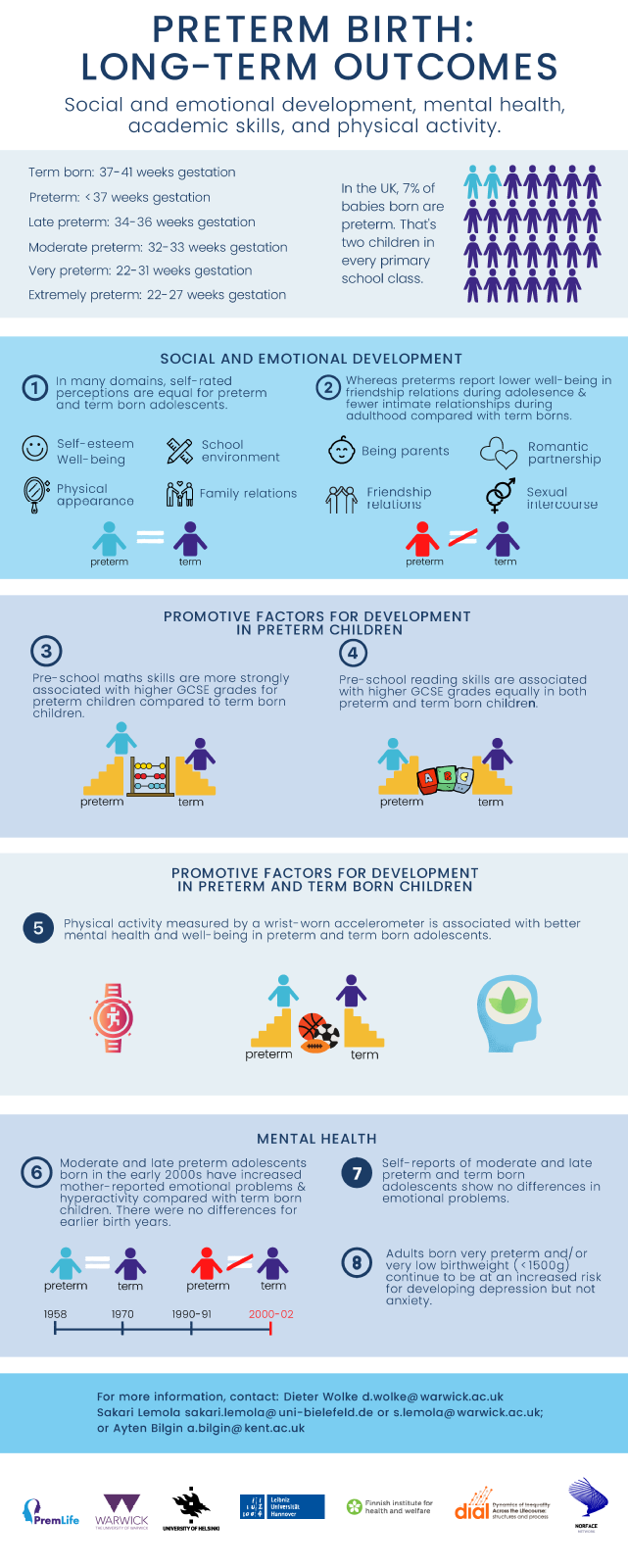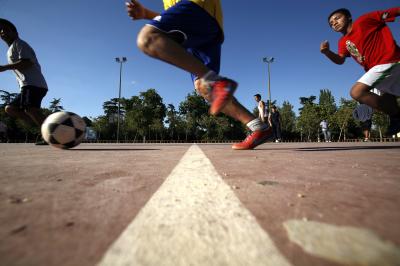PremLife Project Findings
PremLife's Key Findings:
Theme 1. How does preterm birth affect social and emotional development?
There is a large body of evidence to show that preterm birth leads to decreased cognitive abilities later in life. However, there is less knowledge about other important domains of life such as social development (relationships, being a parent, friendships) and emotional development (personality, well-being). PremLife therefore looked into these domains, namely whether there are differences between preterm and term-born children regarding social and emotional development in the home and school environment.
You can also read the video transcipt here.
Theme 2. Long-term mental health outcomes after preterm birth.
The purpose of theme 2 was to investigate whether those born preterm are more at risk for developing mental health problems during adolescence and young adulthood. Many studies have shown that very preterm children and adolescents suffer more often from mental health problems than those born at term.
You can also read the video transcipt here.
PremLife infographic:
(Download here.)

Other studies that are related PremLife:
Preterm birth and wealth in adulthood
In a meta-analysis, researchers from the University of Warwick have shown that adults who were born preterm hold lower educational qualifications, are less likely to be employed, and are more likely to receive social benefits than their peers born at term (Bilgin, Mendonca, & Wolke, 2018). Summarising the findings from 23 studies from across three continents with nearly 6 million participants, the findings were consistent between younger and older adults and between the geographic regions. However, adults who were born very preterm (< 32nd gestational week) hold lower educational qualifications than their peers born moderately to late preterm (32nd to 36th gestational week). Another study by PremLife team members showed that particularly math skills in adolescence were an important protective factor for the wealth among adults who were born preterm (Basten, Jaekel, Johnson, Gilmore, & Wolke, 2015).
Basten M, Jaekel J, Johnson S, Gilmore C, Wolke D. (2015). Preterm birth and adult wealth: mathematics skills count. Psychol Sci. 26(10),1608–1619
Bilgin, A., Mendonca, M., & Wolke, D. (2018). Preterm birth/low birth weight and markers reflective of wealth in adulthood: A meta-analysis. Pediatrics, e20173625.
Associations between maternal antenatal corticosteroid and mental and behavioural disorders in children

Maternal antenatal corticosteroid treatment is standard care to accelerate fetal maturation when very preterm birth (before 34 weeks) is imminent. It prevents neonatal morbidity, respiratory distress syndrome, and brain injury. however the long-term effects of this intervention on term-born children had not previously been examined. In a population-based cohort study of 670,097 children born between 2006 and 2017 in Finland, exposure to maternal antenatal corticosteroid treatment was significantly associated with mental and behavioural disorders in children. These findings may help inform decisions about maternal antenatal corticosteroid treatment.
Räikkönen, K., Gissler, M., Kajantie, E. (2020). Associations between maternal antenatal corticosteroid treatment and mental and behavioural disorders in children. JAMA. 323(19),1924-1933. doi:10.1001/jama.2020.3937 https://www.ncbi.nlm.nih.gov/pmc/articles/PMC7237984
Physical activity, mental health, and well‐being in very pre‐term and term born adolescents

This study looks at whether physical activity is associated with better mental health and well‐being among very preterm (≤32 weeks) and term born (≥37 weeks) adolescents alike or whether the associations are stronger in either of the groups. It finds that those young people in the study who exercised more had fewer problems with their peers, higher levels of psychological well‐being, better self‐perception/body image, and were happier at school. Differences between preterm and term-born children, however, were small. Data were utilised from 2 longitudinal studies of children born in Switzerland and the UK in the early part of the 2000s. The activity levels of around 3,300 of the children were measured using step tracking devices when they were aged around 12 to 14. The children themselves filled in a questionnaire about their well-being and their mothers filled in a questionnaire about their child’s behaviour. We conclude that there is a ‘universal’ protective effect of physical exercise for children but further research taking other forms of exercise into account may provide more useful insights.
Brylka, A., Wolke, D., Ludyga, S., et al. (2021). Physical activity, mental health, and well-being in very pre-term and term born adolescents: An individual participant meta-analysis of two accelerometry studies. International Journal of Enviornmental Research and Public Health. 18,1735. https://doi.org/10.3390/ijerph18041735

